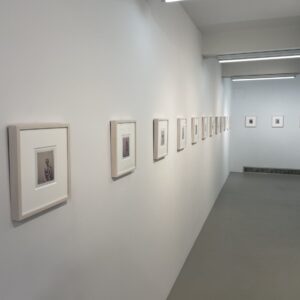JTF (just the facts): A total of 12 color photographic works (10 single images and 2 diptychs), framed in white and unmatted, and hung against white walls in the main gallery space. All of the works are archival pigment pints, made in 2015 and 2016. Each image is available in two sizes (large and small). The single image sizes include 30×20, 30×24, 30×30, 30×45, 40×40, and 56×42, while the diptychs can be as large as 40×40/40×60. All of the prints are available in editions of 7+2AP. A monograph of Marsolier’s earlier work (in a similar style) was published by Kerber Verlag (here) in 2014. (Installation shots below.)
Comments/Context: At the popular studio tour at Paramount Pictures in Los Angeles, one of the main highlights is the recreation of New York city. As the site of countless commercials, television shows, and movies, this backlot (it covers several square blocks) is filled with facades of apartment buildings, brownstones, storefronts, and other urban architecture, in a mix of stately old stone and sleek glass and steel, complete with sidewalks, streetlights, and a subway entrance (to nowhere). But what makes this place convincingly real is the pervasive grit and grime – the paint is worn, faded, and flaking, the sidewalks are cracked, dirty, and dotted with chewing gum, and the streets themselves are mended and uneven. It is this all-over patina of age and imperfection that fools us into believing this stage set is the real thing.
Part of what makes Lauren Marsolier’s new photographs so unsettling is that they deliberately lack this softening scrim of human use. In her constructed landscapes and edge-of-town development-scapes, grassy areas are mown to unreal perfection and concrete paths and plazas extend with smooth geometric precision. Whether it is walls made of cinderblocks, fences of corrugated tin, or arrays of square glass windows, the details of her built worlds feel highly controlled and methodically arranged. The only intrusions on this almost maniacally machined and manicured order are a handful of natural interlopers – a lone tree, a stunted palm, or an urn of red succulents fighting the cloudless blasting sunlight. Even the golf course looks off-kilter somehow, its rolling hills and straight cypresses too carefully arranged to be anything but overtly designed.
Marsolier’s places are really composite non-places made from harmonized image fragments (akin to Andreas Gursky’s stripped down Rhein river views), and this is why we find it so hard to orient ourselves inside them. They exist in a kind of hyper-reality, where our minds recognize both the familiarity of their forms (they look like any other brand new constructed space the world over) and the obvious weirdness of their empty perfection. There are no people here, no sounds, no nothing aside from the echoing structures of these seemingly abandoned towns.
A few images give us a potential clue to our location – vistas of hopelessly harsh rocky terrain in the distance, not unlike the sunbaked surface of an inhospitable planet. Is this eerie place a far off outpost, an isolated prison, or some controlled compound in a dangerous environment? Or maybe we have just found ourselves inside the matrix, where our memories construct something that approximates our old life, but without the necessary detail to make it convincing. An array of plastic chairs (tied together to prevent theft or howling wind) and a tower of apartments give us the impression that there must be other inhabitants around somewhere, but the whistling surreal quiet of Marsolier’s pictures leaves us wondering how to escape this maddening simulacrum of modern existence.
The success in these photographs lies in the push and pull they consistently generate – between real and unreal, between natural and unnatural, and between safe and seemingly menacing. A squiggle of a bike rack, the floral pattern of a cluster of patio furniture, the sag of an abandoned mattress – these flourishes almost make us feel at home. But Marsolier quickly upends that comforting moment of recognition, drawing us back to the dislocating hard edges of this soulless existence.
I think the key conceptual innovation to be found in Marsolier’s photographic approach is the thoughtful rejection of the idea that our newfangled software tools must be used for additive action. Her pictures are all about reduction and erasure, about constructing something and then paring down and removing rather than embellishing. The wary mood of uncertainty she has created is a direct result of this conscious sanitization, her pictures rooted not in the close examination of details, but in the disorienting (and ultimately dehumanizing) lack thereof.
Collector’s POV: The works in this show are priced as follows. The single image prints range from $3200 to $6500 (based on size), while the diptychs range from $7250 to $11000. Marsolier’s work has little secondary market history at this point, so gallery retail remains the best option for those collectors interested in following up.













